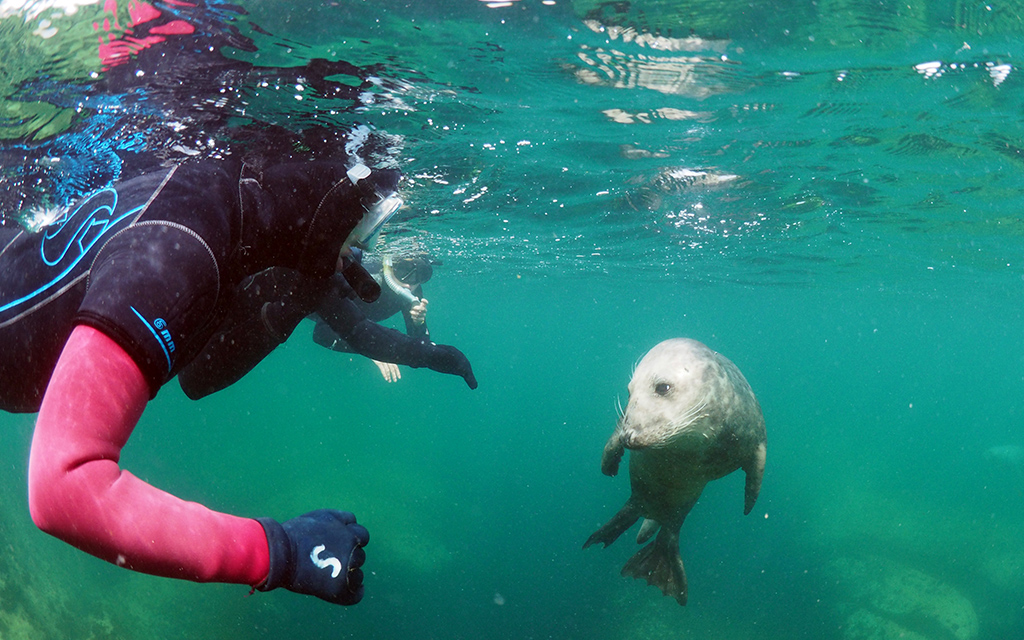
We have enjoyed a warm summer and the sunny conditions extended into the Autumn, but now everything is cooling down and we are getting some cold frosty days mixed in with some mild ones and lots of rain. Time to think about putting our snorkelling kit away for winter... or maybe not.
Although the water temperature is cooling down to around 10ºC in inland lakes and sea lochs, the visibility underwater is generally good so there is much to be enjoyed. Like me, I am sure you will have noticed the growth in the sport of open water swimming. These swimmers now frequent many of the inland dive sites. It is almost embarrassing to share a changing room with them. They put on a swimsuit and possibly a thin wet suit as we put on thick wet suits or even a dry suit, yet we all jump into the same water. I fully acknowledge that their level of activity in water is substantially higher than ours, however, there may be something for us to copy in the way the swimmers enter the water and how they prepare for their exit and after-swim needs. Here are some ideas which could help us enjoy snorkelling in colder water.
Water entries and exits
Swimmers often use a water entry point which allows them to acclimatise slowly to the water temperature and do things at their own comfortable pace. This approach is suitable for snorkellers. As snorkellers we have a Dive Manager, swimmers often have a ‘spotter’ who, like our Dive Manager is also a willing pair of hands to assist people as they exit from the cold water. The swimmers plan their exit and how they are going to get back into their clothes with considerable care. Their plans include towels wrapped in hot water bottles, so the towels are warm and cosy to use; over large, easy-to-put-on robes, fleecy on the inside and windproof on the outside, to help them restore their body heat before starting the process of getting dressed. These are ideas which you may wish to incorporate into your usual plans and preparations for your next open water snorkelling trip.
Site research and homework
When choosing your snorkel sites, it is important to do your research. Heading to familiar sites, whether coastal or inland, is always preferable, but wherever you choose, there are important questions to ask yourself and ensure you know the answers.
No matter where you choose to snorkel, you should think about whether there are other water-users you need to consider e.g. open water swimmers, fishermen, kayakers and canoeists? For inland waters such as a sea loch, a freshwater lake, or a river, it is useful to know the features of the site: bottom type, deep areas, eddies, weirs etc. It is also important to know if you need permission to go into the water. Research site history, as well as the local flora, fauna and aquatic life. Knowing what to look for can really add to the enjoyment of a snorkel dive. Knowledge also helps to identify potential risks – such as the tendency in some areas to throw shopping trollies into the water.
Suitable equipment
It is essential that anyone snorkelling at this time of year has a good, well-fitted, thick wet suit or semi-dry suit as well as suitable well-fitted hoods and gloves. For some, a dry suit is an option to consider but can make finning difficult. Remember getting into wet suits should be left until just before for the snorkellers are to go into the water and the changing back into warm dry clothing is a priority.
Short in-water times
The swimmers go in with a clear plan of how far they will swim and/or for how long. Sound familiar? Make sure no one is subject to ‘peer pressure’ to go into water that is too cold for them. Remember quality of time in-water is preferable to quantity.
Think SAFE – Snorkel SAFE
Marg Baldwin
Snorkel Instructor Trainer
Find out more about snorkel training.
BSAC promote and develop the 'best practice' in snorkelling safety for snorkellers in the UK.
Image credit: Tim Allsop

 Author: Marg Baldwin | Posted 29 Nov 2019
Author: Marg Baldwin | Posted 29 Nov 2019


